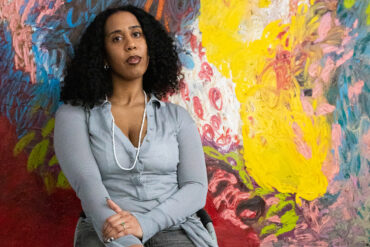
The Bold and Playful Artistry of Milly Thompson

LONDON — In a small rural village in Scotland, an advertisement-style billboard by Milly Thompson (1964–2022) depicted two women in swimwear and scuba gear, swinging their hair in joyful abandon. The models, however, were middle-aged women rather than slim young girls, their faces free of make-up and their skin showing wrinkles and stretch marks. This parody of luxury advertisement is intentionally brash and ugly, demonstrating the defiance of older women who push back against the invisibility assigned to them by patriarchal society. In this work and those for which Thompson is best known, which often draw on the art historical trope of the reclining nude woman, set in semi-abstracted vacation destinations such as sun-drenched beaches, there is an eroticism without objectification — a female gaze that is both empowering and intimate.
“Near Witches” (2021) is re-presented outside the rooftop terrace of a solo exhibition of Thompson’s work at Goldsmiths Centre for Contemporary Art, where it is shown to be both sensual and powerfully irreverent. During the 1990s, she was part of the artist collective BANK, which critiqued and parodied corporate identity, consumerism, and wealth. After the group disbanded, she established a prolific solo practice incorporating painting, sculpture, and video, in which she continued to critique consumer culture, but shifted her focus to consider its relationship with the middle-aged female body — a topic too often overlooked across the history of art.
Throughout Thompson’s work, we see women attempting to free themselves from the entanglements of patriarchy. Several of her most recent paintings, made shortly before her death, use more abstract compositions of line, color, and ink wash to suggest female bodies emerging from jumbled shapes or esoteric symbols and emojis, as if struggling to break free and find visibility. Emojis are both highly specific to contemporary internet culture and expressive of universal emotions and associations, mirroring Thompson’s commentary that women’s experiences are both specific to our era and culture and echoes of history.
Part of the show is dedicated to Thompson’s publications, writings, and collaborations, demonstrating the breadth of her practice. In her 2010 manifesto “I Choose Painting,” reproduced in the exhibition, she claims she “can’t be bothered” to take on complex notions of politics and philosophy. Instead, she will “just accept the hegemony of male materials and let myself scramble in male shit for breath. My thoughts are only of escape, simplicity, sensuality. So I choose painting.” This clever, tongue-in-cheek statement succinctly questions the masculine domination of painting, and poses sensuality as a radical alternative to male expression. Her words and wider practice simultaneously express a deep engagement with the complex issues that determine how women are seen — and see themselves — among the patriarchal capitalist system.
Our notions of beauty, Thompson suggests throughout her work, are deliberately constructed to restrict women and distort their self-image. In these voluptuous and humorous images, by contrast, beauty comes as much from attitude as from aesthetics. As Thompson herself wrote: “I see two sides of my femaleness. One repressed and the other rampant.”
Milly Thompson: My Body Temperature is Feeling Good continues at Goldsmiths Centre for Contemporary Art (St. James’s, New Cross, London), through August 24. The exhibition was curated by Natasha Hoare and Sarah McCrory.